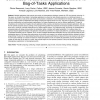2300 search results - page 87 / 460 » Maximally Concurrent Programs |
ESOP
2008
Springer
13 years 11 months ago
2008
Springer
We present a static analysis for inferring the maximum amount of buffer space used by a program consisting of concurrently running processes communicating via buffered channels. We...
TPDS
2008
13 years 10 months ago
2008
Multiple applications that execute concurrently on heterogeneous platforms compete for CPU and network resources. In this paper, we consider the problem of scheduling applications ...
CONCURRENCY
2004
2004
User transparency: a fully sequential programming model for efficient data parallel image processing
13 years 10 months ago
Although many image processing applications are ideally suited for parallel implementation, most researchers in imaging do not benefit from high performance computing on a daily b...
ICC
2008
IEEE
14 years 4 months ago
2008
IEEE
— We introduce a hypergraph based interference model for scheduling in wireless networks. As a generalization of the graph model, hypergraph considers the conflicts caused by su...
SIAMDM
2011
13 years 5 months ago
2011
Let S ⊆ Zn satisfy the property that conv(S) ∩ Zn = S. Then a convex set K is called an S-free convex set if int(K) ∩ S = ∅. A maximal S-free convex set is an S-free convex...

